 The market for crude oil is usually a volatile one. Indeed, in the last few months, the market has seen prices rise and fall due to various supply and demand influences. Crude oil is coined the ‘King of Commodities’ due to the impact it has on consumers, producers and both the micro and macro economy. The price of crude oil affects everything from the cost of producing plastics, transportation, and food at the supermarket.
The market for crude oil is usually a volatile one. Indeed, in the last few months, the market has seen prices rise and fall due to various supply and demand influences. Crude oil is coined the ‘King of Commodities’ due to the impact it has on consumers, producers and both the micro and macro economy. The price of crude oil affects everything from the cost of producing plastics, transportation, and food at the supermarket.
This makes the market for crude oil an economic powerhouse which is closely watched by businesses, traders, and governments. To gain a full understanding of the movements in this market, it is important to identify how demand and supply affect the price of crude oil.
What influences the demand and supply of crude oil?
The law of demand and supply states that if demand increases, prices will rise, and if supply increases, prices will fall. This is exactly what happens in the market for crude oil. The consumer side of the market consists of various companies and hundreds of millions of people. The producer side of the market is made up of oil-producing countries. Collectively, both consumers and producers influence the market price.
However, the demand and supply of crude oil, and therefore the price, is also affected by global economic conditions and geopolitical tensions. What happens in the world impacts the price of oil, especially since a large proportion of the world’s biggest oil producers are in politically unstable areas.
 Over the past five years, global events have had a major impact on the price of oil. The economic conditions created by the impact of the COVID pandemic saw prices plummet from around $55 per barrel just before the pandemic in February 2020 to around $15 per barrel in April 2020. By mid-2021 they had recovered to around $75 per barrel. Then, in the aftermath of Russia’s invasion of Ukraine in February 2022, the price surged to reach $133 in June 2022. More recently, geopolitical tensions in the Middle East and concerns about China’s economic outlook have intensified concerns about the future direction of the market. (Click here for a PowerPoint of the chart.)
Over the past five years, global events have had a major impact on the price of oil. The economic conditions created by the impact of the COVID pandemic saw prices plummet from around $55 per barrel just before the pandemic in February 2020 to around $15 per barrel in April 2020. By mid-2021 they had recovered to around $75 per barrel. Then, in the aftermath of Russia’s invasion of Ukraine in February 2022, the price surged to reach $133 in June 2022. More recently, geopolitical tensions in the Middle East and concerns about China’s economic outlook have intensified concerns about the future direction of the market. (Click here for a PowerPoint of the chart.)
Geopolitical tensions
In the first week of October 2024, the price of crude oil rose by almost 10% to around $78 per barrel as the conflict in the Middle East intensified. It unfortunately comes at a time when many countries are starting to recover from the rise in oil prices caused by the pandemic and the war in Ukraine. Any increase in prices will affect the price that consumers pay to fill up their vehicles with fuel, just when prices of diesel and petrol had reached their lowest level for three years.
 The Governor of the Bank of England, Andrew Bailey, has said that the Bank is monitoring developments in the Middle East ‘extremely closely’, as the conflict has the potential to have serious impacts in the UK. The Bank of England will therefore be watching for any movement in oil prices that could fuel inflation.
The Governor of the Bank of England, Andrew Bailey, has said that the Bank is monitoring developments in the Middle East ‘extremely closely’, as the conflict has the potential to have serious impacts in the UK. The Bank of England will therefore be watching for any movement in oil prices that could fuel inflation.
The main concerns stem from further escalation in the conflict between Israel and the Iran-backed armed group, Hezbollah, in Lebanon. If Israel decides to attack Iran’s oil sector, this is likely to cause a sharp rise in the price of oil. Iran is the world’s seventh largest oil exporter and exports over half of its production to China. If the oilfields of a medium-sized supplier, like Iran, were attacked, this could threaten general inflation in the UK, which could in turn influence any decision by the Bank of England to lower interest rates next month.
Supply deficits
This week (2nd week of October 2024) saw the price of crude oil surge above $81 per barrel to hit its highest level since August. This rise means that prices increased by 12% in a week. However, this surge in price also means that prices rose by almost 21% between the start September and the start of October alone. Yet it was only in early September when crude oil hit a year-to-date low, highlighting the volatility in the market.
As the Middle-East war enters a new and more energy-related phase, the loss of Iranian oil would leave the market in a supply deficit. The law of supply implies that such a deficit would lead to an increase in prices. This also comes at a time when the US Strategic Petroleum Reserve has also been depleted, causing further concerns about global oil supply.
 However, the biggest and most significant impact would be a disruption to flows through the Strait of Hormuz. This is a relatively narrow channel at the east end of the Persian Gulf through which a huge amount of oil tanker traffic passes – about a third of total seaborne-traded oil. It is therefore known as the world’s most important oil transit chokepoint. The risk that escalation could block the Strait of Hormuz could technically see a halt in about a fifth of the world’s oil supply. This would include exports from big Gulf producers, including Saudi Arabia, UAE, Kuwait and Iraq. In a worst-case scenario of a full closure of the Strait, a barrel of oil could very quickly rise to well above $100.
However, the biggest and most significant impact would be a disruption to flows through the Strait of Hormuz. This is a relatively narrow channel at the east end of the Persian Gulf through which a huge amount of oil tanker traffic passes – about a third of total seaborne-traded oil. It is therefore known as the world’s most important oil transit chokepoint. The risk that escalation could block the Strait of Hormuz could technically see a halt in about a fifth of the world’s oil supply. This would include exports from big Gulf producers, including Saudi Arabia, UAE, Kuwait and Iraq. In a worst-case scenario of a full closure of the Strait, a barrel of oil could very quickly rise to well above $100.
Disruption to shipments would also lead to higher gas prices and therefore lead to a rise in household gas and electricity bills. As with oil, gas prices filter down supply chains, affecting the cost of virtually all goods, resulting in a further rise in the cost of living. With energy bills in the UK having already risen by 10% for this winter, an escalation to the conflict could see prices rise further still.
China’s economic outlook

Despite the concern for the future supply of oil, there is also a need to consider how the demand for oil could impact price changes in the market. The price of oil declined on 14 October 2024 in light of concerns over China’s struggling economy. As China is the world’s largest importer of crude oil, there are emerging fears about the potential limits on fuel demand. This fall in price reversed increases made the previous week as investors become concerned about worsening deflationary pressures in China.
Any reduced demand from China could indicate an oversupply of crude oil and therefore potential price declines. Official data from China reveal a sharp year-on-year drop in the producer price index of 2.8% – the fastest decline in six months. These disappointing results have stirred uncertainty about the Chinese government’s economic stimulus plans. Prices could fall further if there are continuing doubts about the government’s ability to implement effective fiscal measures to promote consumer spending and, in turn, economic growth.
As a result of the 2% price fall in oil prices on 14 October, OPEC (the Organization of the Petroleum Exporting Countries) has lowered its 2024 and 2025 global oil demand growth. This negative news outweighed market concerns over the possibility that an Israeli response to Iran’s missile attack could disrupt oil production.
What is the future for oil prices?
 It is expected that the market for oil will remain a volatile one. Indeed, the current uncertainties around the globe only highlight this. It is never a simple task to predict what will happen in a market that is influenced by so many global factors, and the current global landscape only adds to the complexity.
It is expected that the market for oil will remain a volatile one. Indeed, the current uncertainties around the globe only highlight this. It is never a simple task to predict what will happen in a market that is influenced by so many global factors, and the current global landscape only adds to the complexity.
There’s a wide spectrum of predictions about what could come next in the market for crude oil. Given the changes in the first two weeks of October alone, supply and demand factors from separate parts of the globe have made the future of oil prices particularly uncertain. Callum Macpherson, head of commodities at Investec, stated in early October that ‘there is really no way of telling where we will be this time next week’ (see the first BBC News article linked below).
Despite the predominately negative outlook, this is all based on potential scenarios. Caroline Bain, chief commodities economist at Capital Economics suggests that if the ‘worst-case scenario’ of further escalation in the Middle East conflict does not materialise, oil prices are likely to ‘ease back quite quickly’. Even if Iran’s supplies were disrupted, China could turn to Russia for its oil. Bain says that there is ‘more than enough capacity’ globally to cover the gap if Iranian production is lost. However, this does then raise the question of where the loyalty of Saudi Arabia, the world’s second largest oil producer, lies and whether it will increase or restrict further production.
What is certain is that the market for crude oil will continue to be a market that is closely observed. It doesn’t take much change in global activity for prices to move. Therefore, in the current political and macroeconomic environment, the coming weeks and months will be critical in determining oil prices and, in turn, their economic effects.
Articles
- How worried should I be about rising oil prices?
BBC News, Michael Race (4/10/24)
- Interest rates could fall more quickly, hints Bank
BBC News, Dearbail Jordan (3/10/24)
- Oil Prices Eye $100 A Barrel As War Risk Premium Returns
FX Empire, Phil Carr (8/10/24)
- Crude oil futures reverse previous gains following disappointing economic data from China
London Loves Business, Hamza Zraimek (14/10/24)
- Oil falls 2% as OPEC cuts oil demand growth view, China concerns
Reuters, Arathy Somasekhar (14/10/24)
- Could war in the Gulf push oil to $100 a barrel?
The Economist (7/10/24)
- The Commodities Feed: Oil remains volatile
ING Think, Ewa Manthey and Warren Patterson (8/10/24)
- Who and what is driving oil price volatility
FT Alphaville, George Steer (9/10/24)
- Brent crude surges above $80 as conflict and storm spark supply fears
Financial Times, Rafe Uddin and Jamie Smyth (7/10/24)
Questions
- Use a demand and supply diagram to illustrate what has happened to oil prices in the main two scenarios:
(a) Conflict in the Middle East;
(b) Concerns about China’s economic performance.
- How are the price elasticities of demand and supply relevant to the size of any oil price change?
- What policy options do the governments have to deal with the potential of increasing energy prices?
- What are oil futures? What determines oil future prices?
- How does speculation affect oil prices?
 In many countries, train fares at peak times are higher than at off-peak times. This is an example of third-degree price discrimination. Assuming that peak-time travellers generally have a lower price elasticity of demand, the policy allows train companies to increase revenue and profit.
In many countries, train fares at peak times are higher than at off-peak times. This is an example of third-degree price discrimination. Assuming that peak-time travellers generally have a lower price elasticity of demand, the policy allows train companies to increase revenue and profit.
If the sole purpose of ticket sales were to maximise profits, the policy would make sense. Assuming that higher peak-time fares were carefully set, although the number travelling would be somewhat reduced, this would be more than compensated for by the higher revenue per passenger.
But there are external benefits from train travel. Compared with travel by car, there are lower carbon emissions per person travelling. Also, train travel helps to reduce road congestion. To the extent that higher peak-time fares encourage people to travel by car instead, there will be resulting environmental and congestion externalities.
The Scottish experiment with abolishing higher peak-time fares
 In October 2023, the Scottish government introduced a pilot scheme abolishing peak-time fares, so that tickets were the same price at any time of the day. The idea was to encourage people, especially commuters, to adopt more sustainable means of transport. Although the price elasticity of demand for commuting is very low, the hope was that the cross-price elasticity between cars and trains would be sufficiently high to encourage many people to switch from driving to taking the train.
In October 2023, the Scottish government introduced a pilot scheme abolishing peak-time fares, so that tickets were the same price at any time of the day. The idea was to encourage people, especially commuters, to adopt more sustainable means of transport. Although the price elasticity of demand for commuting is very low, the hope was that the cross-price elasticity between cars and trains would be sufficiently high to encourage many people to switch from driving to taking the train.
One concern with scrapping peak-time fares is that trains would not have the capacity to cope with the extra passengers. Indeed, one of the arguments for higher peak-time fares is to smooth out the flow of passengers during the day, encouraging those with flexibility of when to travel to use the cheaper and less crowded off-peak trains.
This may well apply to certain parts of the UK, but in the case of Scotland it was felt that there would be the capacity to cope with the extra demand at peak time. Also, in a post-COVID world, with more people working flexibly, there was less need for many people to travel at peak times than previously.
Reinstatement of peak-time fares in Scotland
It was with some dismay, therefore, especially by commuters and environmentalists, when the Scottish government decided to end the pilot at the beginning of October 2024 and reinstate peak-time fares – in many cases at nearly double the off-peak rates. For example, the return fare between Glasgow and Edinburgh rose from £16.20 to £31.40 at peak times.
The Scottish government justified the decision by claiming that passenger numbers had risen by only 6.8%, when, to be self-financing, an increase of 10% would have been required. But this begs the question of whether it was necessary to be self-financing when the justification was partly environmental. Also, the 6.8% figure is based on a number of assumptions that could be challenged (see The Conversation article linked below). A longer pilot would have helped to clarify demand.
Other schemes
A number of countries have introduced schemes to encourage greater use of the railways or other forms of public transport. One of these is the flat fare for local journeys. Provided that this is lower than previously, it can encourage people to use public transport and leave their car at home. Also, its simplicity is also likely to be attractive to passengers. For example, in England bus fares are capped at £2. Currently, the scheme is set to run until 31 December 2024.
 Another scheme is the subscription model, whereby people pay a flat fee per month (or week or year, or other time period) for train or bus travel or both. Germany, for example, has a flat-rate €49 per month ‘Deutschland-Ticket‘ (rising to €58 per month in January 2025). This ticket provides unlimited access to local and regional public transport in Germany, including trains, buses, trams, metros and ferries (but not long-distance trains). This zero marginal fare cost of a journey encourages passengers to use public transport. The only marginal costs they will face will be ancillary costs, such as getting to and from the train station or bus stop and having to travel at a specific time.
Another scheme is the subscription model, whereby people pay a flat fee per month (or week or year, or other time period) for train or bus travel or both. Germany, for example, has a flat-rate €49 per month ‘Deutschland-Ticket‘ (rising to €58 per month in January 2025). This ticket provides unlimited access to local and regional public transport in Germany, including trains, buses, trams, metros and ferries (but not long-distance trains). This zero marginal fare cost of a journey encourages passengers to use public transport. The only marginal costs they will face will be ancillary costs, such as getting to and from the train station or bus stop and having to travel at a specific time.
Articles
- Why a pilot scheme removing peak rail fares should have been allowed to go the distance
The Conversation, Rachel Scarfe (8/10/24)
- Return of peak rail fares a costly blow for commuters and climate, Scottish Greens say
Bright Green, Chris Jarvis (6/10/24)
 Commuters react to return of peak train fares in Scotland
Commuters react to return of peak train fares in ScotlandBBC News (1/10/24)
- Perth peak rail fares to Edinburgh rise by almost 60 percent as pilot scheme ends
Daily Record, Alastair McNeill (4/10/24)
- Ditch peak-time rail fares across UK, campaigners say
iNews, Adam Forrest (30/9/24)
- Train fares reduced by up to 20% in East Yorkshire
Rail Advent, Roger Smith (26/9/24)
- Deutschland-Ticket: Germany’s popular monthly transport pass will soon be more expensive
Euronews, Angela Symons (24/9/24)
- Fare Britannia: a new approach to public transport ticketing for the UK
Greenpeace report, Leo Eyles, Tony Duckenfield and Jim Steer (19/9/24)
- Ministers urged to trial monthly ‘climate card’ in North of England to save rail commuters money and cut emissions
About Manchester, Nigel Barlow (20/9/24)
Questions
- Identify the arguments for and against having higher rail fares at peak times than at off-peak times
- Why might it be a good idea to scrap higher peak-time fares in some parts of a country but not in others?
- Provide a critique of the Scottish government’s arguments for reintroducing higher peak-time fares.
- With reference to The Conversation article, why is it difficult to determine the effect on demand of the Scottish pilot of scrapping peak-time fares?
- What are the arguments for and against the German scheme of having a €49 per month public transport pass for local and regional transport with no further cost per journey? Should it be extended to long-distance trains and coaches?
- In England there is a flat £2 single fare for buses. Would it be a good idea to make bus travel completely free?
 Coffee prices have been soaring in recent months. This applies to the prices of both coffee beans on international markets, coffee in supermarkets and coffee in coffee shops. In this blog we examine the causes and what is likely to happen over the coming months.
Coffee prices have been soaring in recent months. This applies to the prices of both coffee beans on international markets, coffee in supermarkets and coffee in coffee shops. In this blog we examine the causes and what is likely to happen over the coming months.
As we shall see, demand and supply analysis provides a powerful explanation of what has been happening in the various sectors of the industry and the likely future path of prices.
The coffee industry
The cultivating, processing and retailing of coffee is big business. It is the second most widely traded commodity after oil and around 2.5 billion cups are consumed worldwide on a daily basis. In the UK nearly 100 million cups of coffee a day are drunk, with coffee consumers spending around £4 billion per year on sit-down and takeaway coffees and on coffee bought in supermarkets and other shops for making at home. The average takeaway coffee costs around £3.40 per cup with speciality coffees costing more.
Global production in the coffee year 2023/24 was 178 million 60 kg bags (10.7 million tonnes) and the annual income of the whole sector exceeds $200 billion. Around 25 million farmers spread across 50 countries harvest coffee. The majority of these farms are small and family run. Some 100 million families worldwide depend on coffee for their living.
Brazil is by far the biggest producer and accounts for nearly 40% of the market. A good or poor harvest in Brazil can have a significant impact on prices. Vietnam and Columbia are the second and third biggest producers respectively and, with Brazil, account for over 60% of global production.
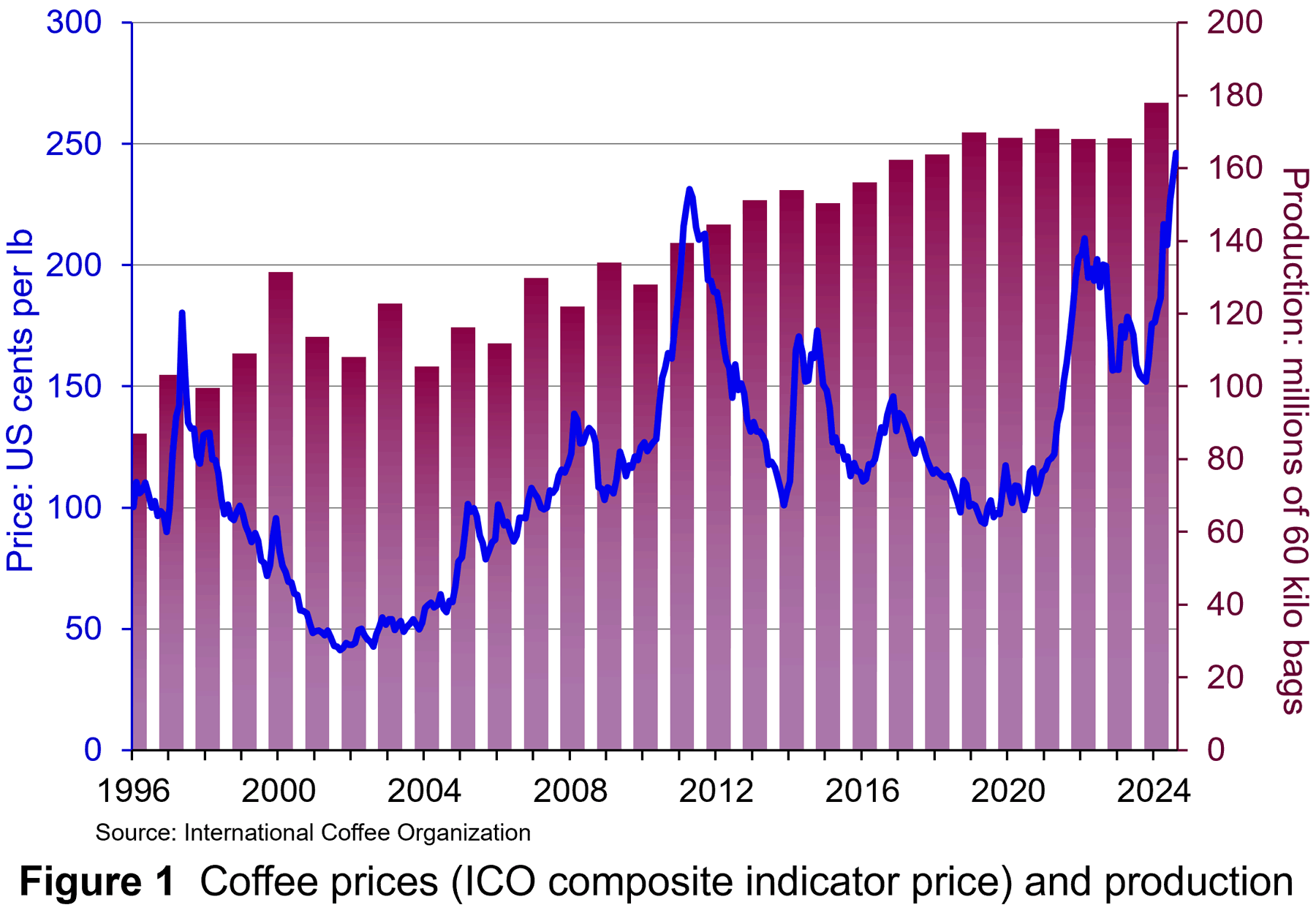 Coffee prices are extremely volatile – more so than production, which does, nevertheless, fluctuate with the harvest. Figure 1 shows global coffee production and prices since 1996. The price is the International Coffee Organization’s composite indicator price (I-CIP) in US cents per pound (lb). It is a weighted average of four prices: Colombian milds (Arabica), Other milds (Arabica), Brazilian naturals (mainly Arabica) and Robusta. Production is measured in 60 kilo bags.
Coffee prices are extremely volatile – more so than production, which does, nevertheless, fluctuate with the harvest. Figure 1 shows global coffee production and prices since 1996. The price is the International Coffee Organization’s composite indicator price (I-CIP) in US cents per pound (lb). It is a weighted average of four prices: Colombian milds (Arabica), Other milds (Arabica), Brazilian naturals (mainly Arabica) and Robusta. Production is measured in 60 kilo bags.
Case Study 2.3 on the student website for Economics 11th edition, looks at the various events that caused the fluctuations in prices and supply illustrated in Figure 1 (click here for a PowerPoint). In this blog we focus on recent events.
Why are coffee prices rising?
 In early October 2023, the ICO composite indicator price (I-CIP), was $1.46 per lb. By 28 August, it had reached $2.54 – a rise of 74%. Colombian milds (high-quality Arabica) had risen from $1.79 per lb to $2.78 – a rise of 55%. Robusta coffee is normally cheaper than Arabica. It is mainly used in instant coffee and for espressos. As the price of Arabica rose, so there was some substitution, with Robusta coffees being added to blends. But as this process took place, so the gap between the Arabica and Robusta prices narrowed. Robusta prices rose from $1.14 in early October 2023 to £2.36 in late August – a rise of 107%. These prices are illustrated in Figure 2 (click here for a PowerPoint).
In early October 2023, the ICO composite indicator price (I-CIP), was $1.46 per lb. By 28 August, it had reached $2.54 – a rise of 74%. Colombian milds (high-quality Arabica) had risen from $1.79 per lb to $2.78 – a rise of 55%. Robusta coffee is normally cheaper than Arabica. It is mainly used in instant coffee and for espressos. As the price of Arabica rose, so there was some substitution, with Robusta coffees being added to blends. But as this process took place, so the gap between the Arabica and Robusta prices narrowed. Robusta prices rose from $1.14 in early October 2023 to £2.36 in late August – a rise of 107%. These prices are illustrated in Figure 2 (click here for a PowerPoint).
This dramatic rise in prices is the result of a number of factors.
 Supply-side factors. The first is poor harvests, which will affect future supply. Frosts in Brazil have affected Arabica production. Also, droughts – partly the result of climate change – have affected harvests in major Robusta-producing countries, such as Vietnam and Indonesia. With the extra demand from the substitution for Arabica, this has pushed up Robusta prices as shown in Figure 2. Another supply-side issue concerns the increasingly vulnerability of coffee crops to diseases, such as coffee rust, and pests. Both reduce yields and quality.
Supply-side factors. The first is poor harvests, which will affect future supply. Frosts in Brazil have affected Arabica production. Also, droughts – partly the result of climate change – have affected harvests in major Robusta-producing countries, such as Vietnam and Indonesia. With the extra demand from the substitution for Arabica, this has pushed up Robusta prices as shown in Figure 2. Another supply-side issue concerns the increasingly vulnerability of coffee crops to diseases, such as coffee rust, and pests. Both reduce yields and quality.
As prices have risen, so this has led to speculative buying of coffee futures by hedge funds and coffee companies. This has driven up futures prices, which will then have a knock-on effect on spot (current) prices as roasters attempt to build coffee stocks to beat the higher prices.
There have also been supply-chain problems. Attacks on shipping by Houthi rebels in the Red Sea have forced ships to take the longer route around the Cape of Good Hope. Again, this has particularly affected the supply of Robusta, largely grown in Asia and East Africa.
New EU regulation banning the import of coffee grown in areas of cleared rainforest will further reduce supply when it comes into force in 2025, or at least divert it away from the EU – a major coffee-consuming region.
 Demand-side factors. On the demand side, the rise of the coffee culture and a switch in demand from tea to coffee has led to a steady growth in demand. Growth in the coffee culture has been particularly high in Asian markets as rapid urbanistion, a growing middle class and changing lifestyles drive greater coffee consumption and greater use of coffee shops. This has more than offset a slight decline in coffee shop sales in the USA. In the UK, the number of coffee shops has risen steadily. In 2023, there were 3000 cafés, coffee chains and other venues serving coffee, of which 9885 were branded coffee shop outlets, such as Costa, Caffè Nero and Starbucks. Sales in such coffee chains rose by 11.9% in 2023. Similar patterns can be observed in other countries, all helping to drive a rise in demand.
Demand-side factors. On the demand side, the rise of the coffee culture and a switch in demand from tea to coffee has led to a steady growth in demand. Growth in the coffee culture has been particularly high in Asian markets as rapid urbanistion, a growing middle class and changing lifestyles drive greater coffee consumption and greater use of coffee shops. This has more than offset a slight decline in coffee shop sales in the USA. In the UK, the number of coffee shops has risen steadily. In 2023, there were 3000 cafés, coffee chains and other venues serving coffee, of which 9885 were branded coffee shop outlets, such as Costa, Caffè Nero and Starbucks. Sales in such coffee chains rose by 11.9% in 2023. Similar patterns can be observed in other countries, all helping to drive a rise in demand.
But although demand for coffee in coffee shops is growing, the rise in the price of coffee beans should have only a modest effect on the price of a cup of coffee. The cost of coffee beans purchased by a coffee shop accounts for only around 10% of the price of a cup. To take account of the costs to the supplier (roasting, distribution costs, overheads, etc), this price paid by the coffee shop/chain is some 5 times the cost of unroasted coffee beans on international markets. In other words, the international price of coffee beans accounts for only around 2% of the cost of a cup of coffee in a coffee shop.
Higher coffee-shop prices are thus mainly the result of other factors. These include roasting and other supplier costs, rising wages, rents, business rates, other ingredients such as milk and sugar, coffee machines, takeaway cups, heating, lighting, repairs and maintenance and profit. The high inflation over the past two years, with several of these costs being particularly affected, has been the major driver of price increases in coffee shops.
The future
 The rise in demand and prices over the years has led to an increase in supply as more coffee bushes are planted. As Figure 1 shows, world supply increased from 87 million in 1995/6 to 178 million 60 kilo bags in 2023/4 – a rise of 105%. The current high prices may stimulate farmers to plant more. But as it can take four years for coffee plants to reach maturity, it may take time for supply to respond. Later on, a glut might even develop! This would be a case of the famous cobweb model (see Case Study 3.13 on the Essentials of Economics 9th edition student website).
The rise in demand and prices over the years has led to an increase in supply as more coffee bushes are planted. As Figure 1 shows, world supply increased from 87 million in 1995/6 to 178 million 60 kilo bags in 2023/4 – a rise of 105%. The current high prices may stimulate farmers to plant more. But as it can take four years for coffee plants to reach maturity, it may take time for supply to respond. Later on, a glut might even develop! This would be a case of the famous cobweb model (see Case Study 3.13 on the Essentials of Economics 9th edition student website).
Nevertheless, climate change is making coffee production more vulnerable and demand is likely to continue to outstrip supply. Much of the land currently used to produce Arabica will no longer be suitable in a couple of decades. New strains of bean may be developed that are more hardy, such as variants of the more robust Robusta beans. Whether this will allow supply to keep up with demand remains to be seen.
Articles
- Even more expensive coffee prices are brewing, but there are some good reasons why
The Conversation, Jonathan Morris (31/7/24)
- Coffee is becoming a luxury, and there’s no escaping it
AccuWeather, Erika Tulfo (1/8/24)
- Coffee prices will rise even higher, says Giuseppe Lavazza
The Guardian, Jonathan Yeboah (9/7/24)
- Coffee prices set to rise even higher, warns Italian roaster Lavazza
Financial Times, Susannah Savage (9/7/24)
- Soaring coffee prices force roasters to add lower-cost beans to blends
Financial Times, Susannah Savage (24/8/24)
- Soaring coffee prices foretell a financial grind
Reuters, Robert Cyran (31/8/24)
- Projected Coffee Price Increase Due to Supply Shortages and Rising Demand
ISN Magazine: International Supermarket News (14/8/24)
- Coffee Market Report
International Coffee Organization (July 2024)
- Strengthening global robusta production: an update
World Coffee Research: News (4/12/23)
- Houthi rebels and the EU make your coffee more expensive
Politico, Carlo Martuscelli (13/8/24)
Data
Questions
- Use a demand and supply diagram to compare the coffee market in August 2024 with that in October 2023.
- How is the price elasticity of demand relevant to determining the size of price fluctuations in response to fluctuations in the supply of coffee? Demonstrate this with a supply and demand diagram.
- How has speculation affected coffee prices?
- What are ‘coffee futures’? How do futures prices relate to spot prices?
- What is likely to happen to coffee prices in the coming months? Explain.
- Why have Robusta prices risen by a larger percentage than Arabica prices? Is this trend likely to continue?
- Look at the price of Colombian Arabica coffee in your local supermarket. Work out what the price would be per lb and convert it to US dollars. How does this retail price compare with the current international price for Colombian milds and what accounts for the difference? (For current information on Colombian milds, see the third data link above.)
- Distinguish between the fixed and variable costs of an independent coffee shop. How should the coffee shop set its prices in relation to these costs and to demand?
 The UK Competition and Markets Authority (CMA) has been investigating road fuel pricing in the UK. In July 2022, it launched a study into the development of the road-fuel market over recent years. The final report of this study was published in July 2023 and covered the refining, wholesale and retail elements of the market.
The UK Competition and Markets Authority (CMA) has been investigating road fuel pricing in the UK. In July 2022, it launched a study into the development of the road-fuel market over recent years. The final report of this study was published in July 2023 and covered the refining, wholesale and retail elements of the market.
In the retail part of the market, the CMA noted some potential causes for concern: retailer fuel margins had increased; there were geographical variations in pricing; filling stations with fewer competitors tended to charge higher prices; retail prices tended to rise rapidly when oil prices increased but fell slowly when oil prices fell (known as ‘rocket and feather’ pricing patterns); motorway service stations charged considerably higher prices than supermarkets or other filling stations.
In response to these findings, the CMA has been publishing an interim report every four months. These reports give average pump prices and margins. They also give relative average pump prices between different types of retailer, and between each of the supermarkets.
The latest interim report was published on 26 July 2024. It reiterated the finding of the 2023 report that the fuel market has become less competitive since 2019. What is more, it continues to be so. In particular, the range of retail prices and the level of retail margins remain high compared to historic levels. The interim report estimates that ‘the increase in retailers’ fuel margins compared to 2019 resulted in increased fuel costs for drivers in 2023 of over £1.6bn’.
Price leadership
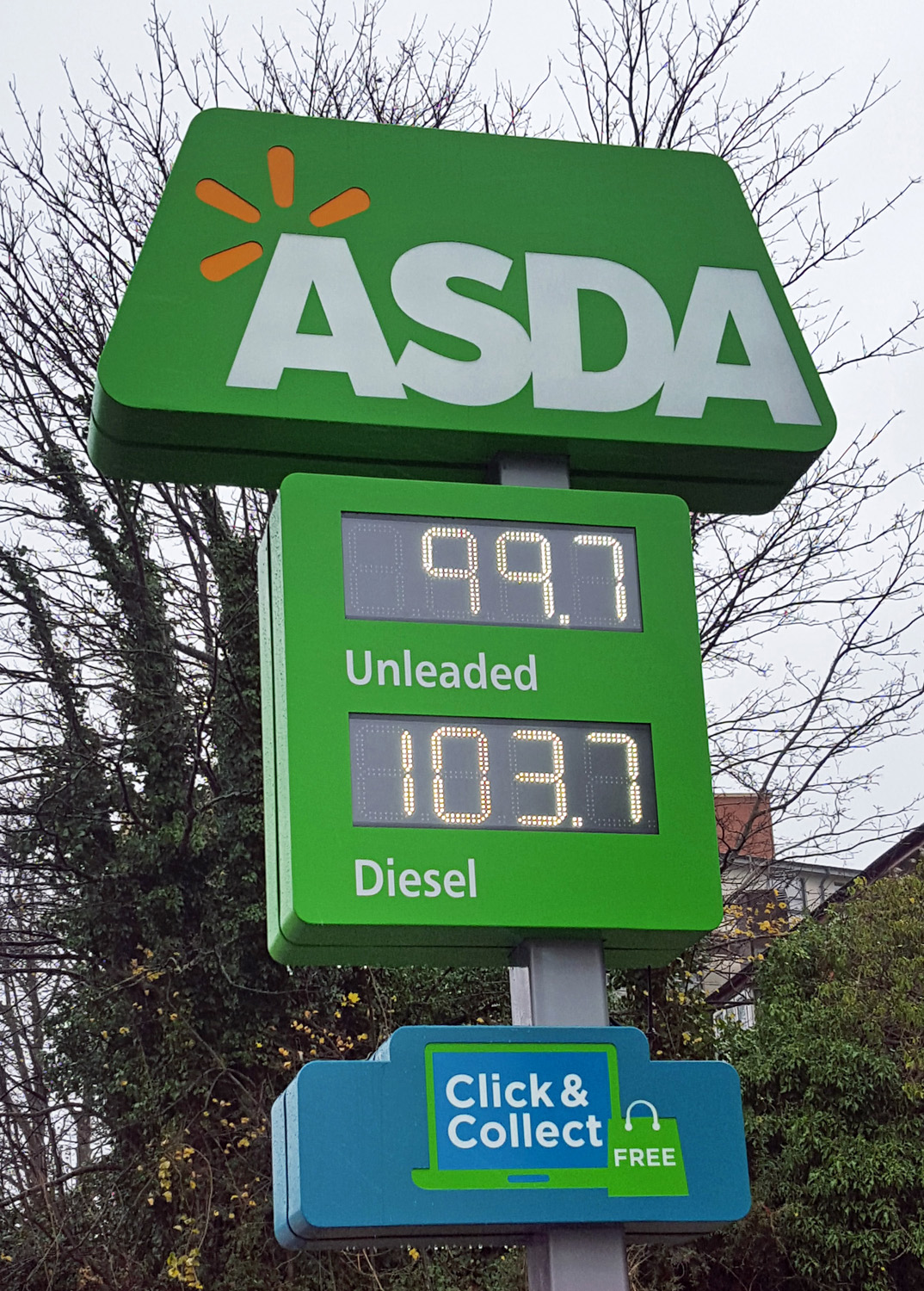 Road fuel retailing is an oligopoly, with the major companies being the big supermarkets, the retail arms of oil companies (such as Shell, BP, Esso and Texaco, operating their own filling stations) and a few large specialist companies, such as the Motor Fuel Group (MFG), the EG Group and Rontec, whose filling stations sell one or other of the main brands. But although it is an oligopoly producing a homogeneous product, it is not a cartel (unlike OPEC). Nevertheless, there has been a high degree of tacit collusion in the market with price competition limited to certain rules of behaviour in particular locations. A familiar one is setting prices ending in .9 of a penny (e.g. 142.9p), with the acceptance by competitors that Applegreen will set it ending at .8 of a penny and Asda at .7 of a penny.
Road fuel retailing is an oligopoly, with the major companies being the big supermarkets, the retail arms of oil companies (such as Shell, BP, Esso and Texaco, operating their own filling stations) and a few large specialist companies, such as the Motor Fuel Group (MFG), the EG Group and Rontec, whose filling stations sell one or other of the main brands. But although it is an oligopoly producing a homogeneous product, it is not a cartel (unlike OPEC). Nevertheless, there has been a high degree of tacit collusion in the market with price competition limited to certain rules of behaviour in particular locations. A familiar one is setting prices ending in .9 of a penny (e.g. 142.9p), with the acceptance by competitors that Applegreen will set it ending at .8 of a penny and Asda at .7 of a penny.
One of the main forms of tacit collusion in areas where there are several filling stations is that of price leadership. Asda, and in some areas Morrisons, have been price leaders, setting the lowest price for that area, with other filling stations setting the price at or slightly above that level (e.g. 0.2p, 1.2p or 2.2p higher). Indeed, other major retailers, such as Tesco, Sainsbury’s, Esso and Shell took a relatively passive approach to pricing, unwilling to undercut Asda and accept lower profit margins.
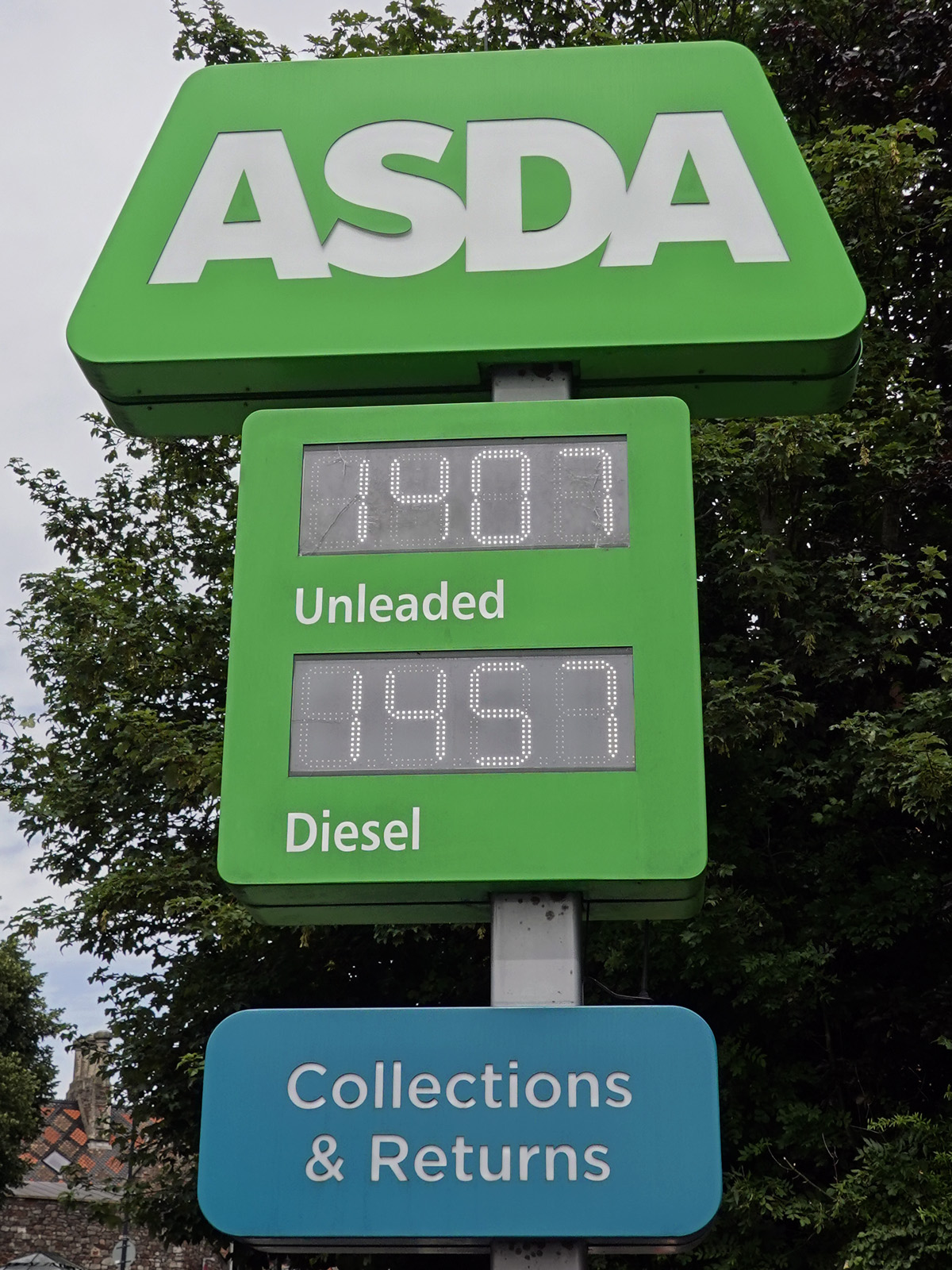 Things changed after 2019. Asda chose to increase its profit margins. In 2022 it did this by reducing prices more slowly than would previously have been the case as wholesale prices fell. In other words, it used price feathering. Other big retailers might have been expected to use the opportunity to undercut Asda. Instead, they decided to increase their own margins by following a similar pricing path. The result was a 6 pence per litre increase in the average supermarket fuel margin from 2019 to 2022.
Things changed after 2019. Asda chose to increase its profit margins. In 2022 it did this by reducing prices more slowly than would previously have been the case as wholesale prices fell. In other words, it used price feathering. Other big retailers might have been expected to use the opportunity to undercut Asda. Instead, they decided to increase their own margins by following a similar pricing path. The result was a 6 pence per litre increase in the average supermarket fuel margin from 2019 to 2022.
More recently, Asda has increased its margins more than other major retailers, making it no longer the price leader. The effect has been to put less pressure on other retailers to trim their now higher profit margins.
Remedies
The 2023 CMA report made two specific recommendations to deal with this rise in profit margins.
The first was that the CMA should be given a statutory monitoring function over the fuel market to ‘hold the industry to account’. In May this year, legislation was passed to this effect. This requires the CMA to monitor the industry and report anti-competitive practice to the government.
The second was to introduce a new statutory ‘open data real-time fuel finder scheme’. This would give motorists access to live, station-by-station fuel prices.
Several major retailers already contribute to a voluntary price data sharing scheme. However, this covers only around 40% of UK forecourts. According to the CMA, it ‘falls well short of the comprehensive, real-time, station-by station data needed to empower motorists and drive competition’. The CMA has thus called on the new Labour government to introduce legislation to make its recommended system compulsory. This, it is hoped, would make the retail fuel market much more competitive by improving consumer information about prices at alternative filling stations in their area.
Articles
CMA reports
Questions
- What forms can tacit collusion take?
- Why are fuel prices at motorway service stations so much higher than in towns? What is the relevance of the price elasticity of demand to the answer?
- What are the main findings of the CMA’s July 2024 Interim Report
- What is meant by rocket and feather pricing?
- What recommendations does the CMA make for increasing competition in the retail road fuel market?
- Find out how competitive retail fuel pricing is in two other developed countries. Why are they more or less competitive than the UK?
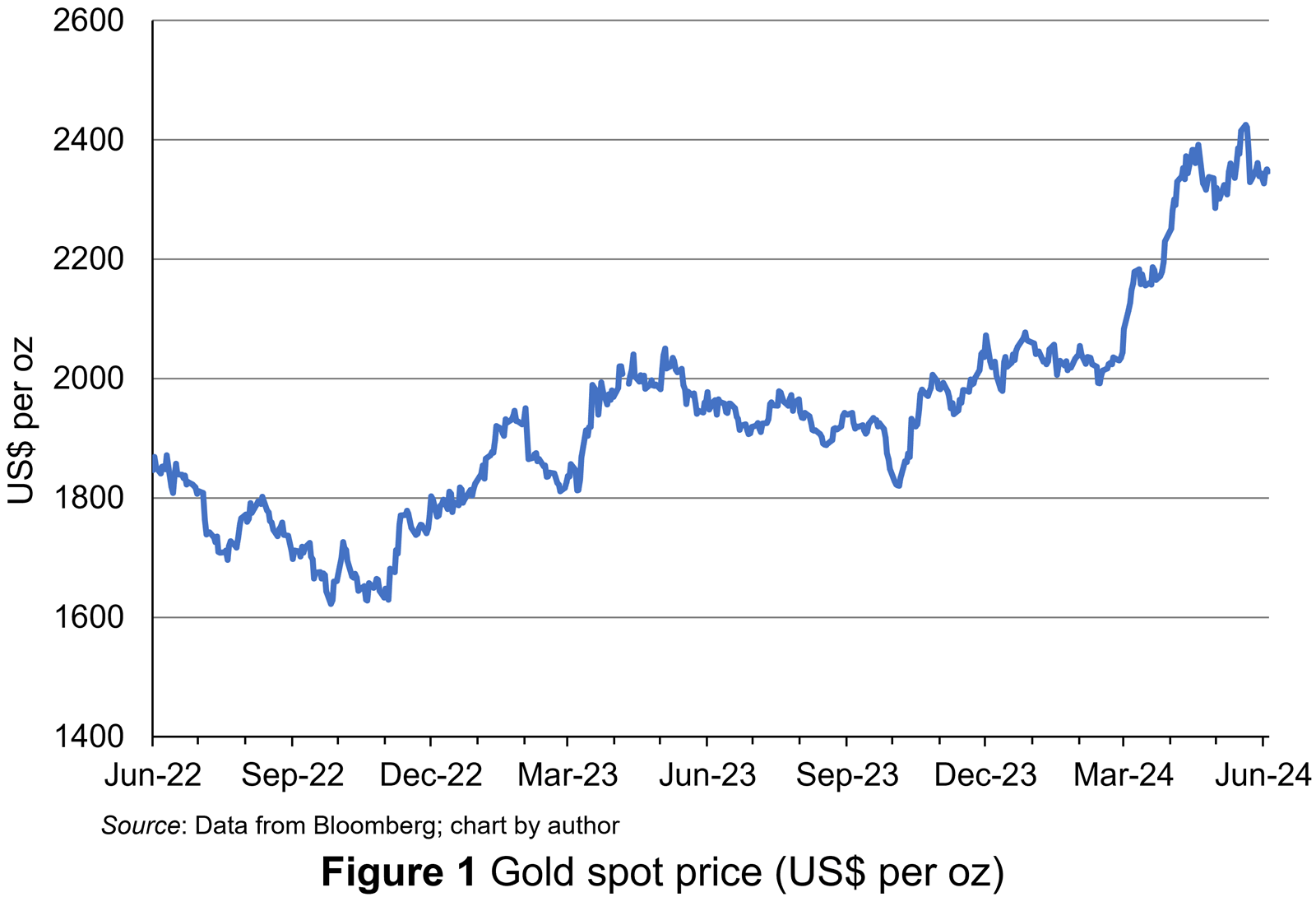 Gold has always held an allure and with the price of gold on international markets trending upwards since October 2022 (see Figure 1: click here for a PowerPoint), people seem to be attracted to it once again. The price reached successively higher peaks throughout 2023 before surging to above $2300 per oz in 2024 and peaking at $2425.31 per oz on 20 May 2024.
Gold has always held an allure and with the price of gold on international markets trending upwards since October 2022 (see Figure 1: click here for a PowerPoint), people seem to be attracted to it once again. The price reached successively higher peaks throughout 2023 before surging to above $2300 per oz in 2024 and peaking at $2425.31 per oz on 20 May 2024.
While gold tends to become attractive during wartime, economic uncertainty and bouts of inflation, all of which have characterised the last few years, the sustained price rise has perplexed market analysts and economists. The rally had been expected to peter out over the past 20 months. But, as the price of gold rose to sustained higher levels, with no significant reversals, some analysts have speculated that it is not the typical short-term factors which are driving the increased demand for and price of gold but more fundamental changes in the global economic system.
This blog will first discuss the typical short-term factors which influence gold prices before discussing the potential longer-term forces that may be at work.
Short-term factors
So, what are the typical short-term economic forces which drive the demand for gold?
The most significant are the real rates of interest on financial assets. These rates represent the opportunity cost of holding an asset such as gold which offers no income stream. When the real return from financial assets like debt and equity instruments is low, the demand for and price of gold tends to be high. In contrast, when the real return from such assets is high, the price of gold tends to be lower. An explanation for this is that real rates of return are strongly related to inflation rates and investors perceive gold as a hedge against inflation since its price is positively correlated with a general rise in prices. Higher unexpected inflation reduces the real rate of return of securities like debt and equity whose value is derived from cash flows anticipated in the future. In such circumstances, gold become an attractive alternative investment. As inflationary expectations decline, real returns from financial assets should rise, and the demand for gold should fall.
 The relationship between real returns, proxied by the yield on US 10-year TIPS (Treasury inflation-protected securities), and gold prices can be used to examine this explanation. Real returns rose steadily in the aftermath of the COVID-19 pandemic. Yet the price of gold, which rose during the early stages of the pandemic in 2020, has not fallen. Instead, it has remained at elevated levels for much of that time (see Figure 2: click here for a PowerPoint).
The relationship between real returns, proxied by the yield on US 10-year TIPS (Treasury inflation-protected securities), and gold prices can be used to examine this explanation. Real returns rose steadily in the aftermath of the COVID-19 pandemic. Yet the price of gold, which rose during the early stages of the pandemic in 2020, has not fallen. Instead, it has remained at elevated levels for much of that time (see Figure 2: click here for a PowerPoint).
There have been short periods when changes in real returns seemed to have a high correlation with changes in gold prices. In late 2022, for example, falling real rates coincided with rising gold prices. The same pattern was repeated between October and December 2023. However, when real returns rose again in the New Year of 2024, in response to stubbornly higher expected inflation and the expectation of ‘higher-for-longer’ interest rates, particularly in the USA, gold prices continued to rise. Indeed, across the 5-year period the correlation coefficient between the two series is actually positive at 0.268, showing little evidence supporting this explanation for the pattern for the gold price.
Real returns in the USA, however, may not be the correct ones to consider when seeking explanations for the pattern of gold’s price. Much of the recent demand is from China. Analysts suggest that Chinese investors are looking for a safe asset to hold as their economy stagnates and real returns from alternatives, like domestic property and equity, have decreased. Further, there are some concerns that the Chinese currency, the renminbi, may be undervalued in response to the sluggish growth. Holding gold is a good hedge against inflation (currency depreciation produces inflationary pressure). Consequently, the Chinese market may be exerting pricing power in relation to real returns in a way not seen before (see the Dempsey and Leng FT article linked below).
However, some analysts suggest that the rise in price is disproportionate to these short-term factors and point to potential long-term structural changes in the global financial order which may produce significant changes in the market for gold.
Long-term factors
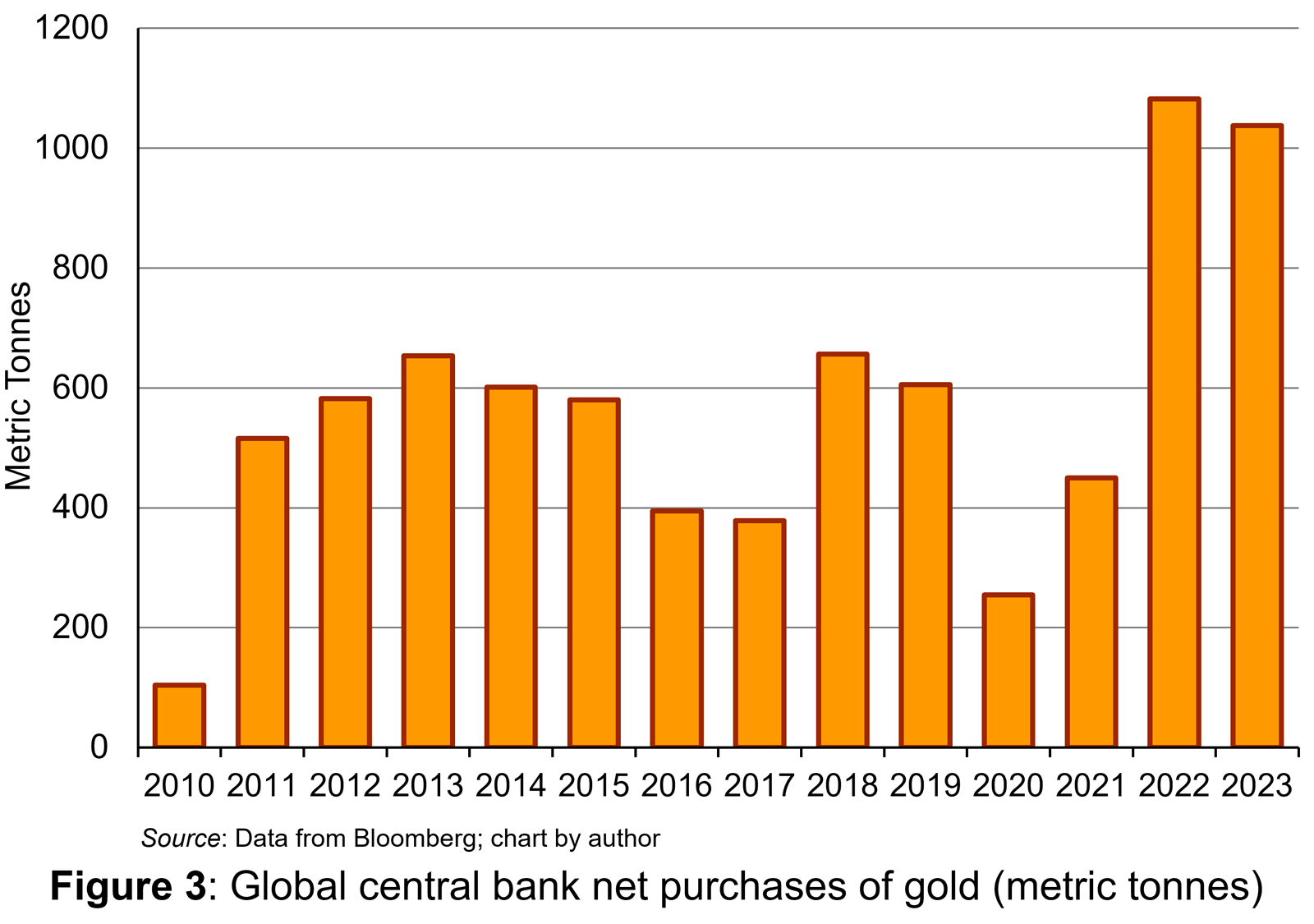 Since 2018, there have been bouts of gold purchasing by central banks around the world. In contrast to the 1990s and 2000s, central banks have been net purchasers since 2010. The purchasing fell back during the coronavirus pandemic but has surged again, with over 1000 metric tonnes purchased in both 2022 and 2023 (see Figure 3: click here for a PowerPoint).
Since 2018, there have been bouts of gold purchasing by central banks around the world. In contrast to the 1990s and 2000s, central banks have been net purchasers since 2010. The purchasing fell back during the coronavirus pandemic but has surged again, with over 1000 metric tonnes purchased in both 2022 and 2023 (see Figure 3: click here for a PowerPoint).
Analysts have pointed to similarities between the recent pattern and central bank purchases of gold during the late 1960s and early 1970s (see The Conversation article linked below). Then, central banks sought to diversify themselves from dollar-denominated assets due to concerns about higher inflation in the USA and its impact on the value of the US dollar. Under the Bretton Woods fixed exchange rate system, central banks could redeem dollars for gold from the US Federal Reserve at a fixed rate. The pressure on the USA to redeem the gold led to the collapse of the Bretton Woods fixed exchange rate system.
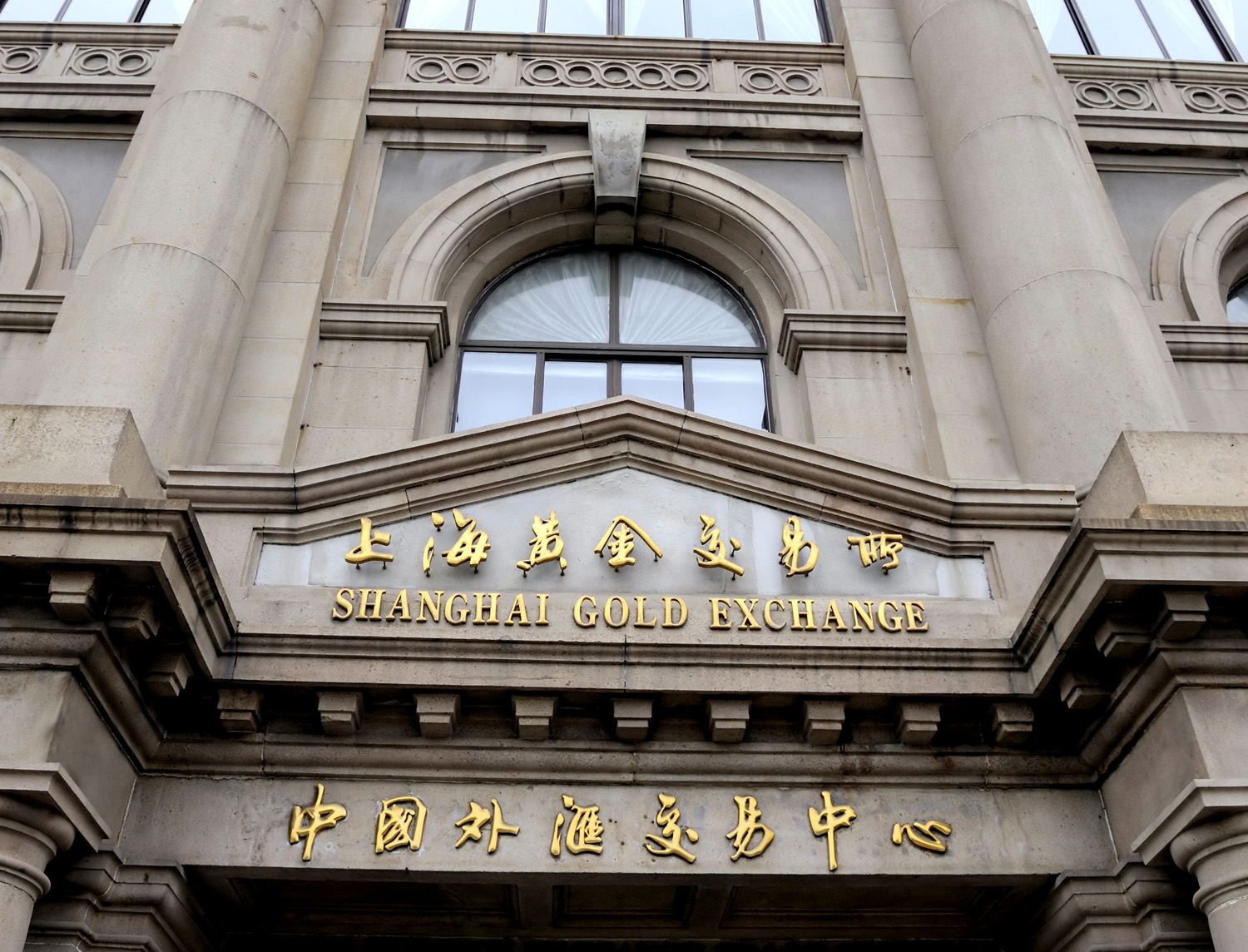 While the current period of central bank purchases does not appear to be related to expected inflation, some commentators suggest it could signal a regime change in the global financial system as significant as the collapse of Bretton Woods. The rise of Chinese political power and the resurgence of US isolationist tendencies portend an increasingly multipolar geopolitical scene. Such concerns may cause central bankers to diversify away from dollar denominated assets to avoid being caught out by geopolitical tensions. Gold may be perceived as an asset through which investors can hedge that risk better.
While the current period of central bank purchases does not appear to be related to expected inflation, some commentators suggest it could signal a regime change in the global financial system as significant as the collapse of Bretton Woods. The rise of Chinese political power and the resurgence of US isolationist tendencies portend an increasingly multipolar geopolitical scene. Such concerns may cause central bankers to diversify away from dollar denominated assets to avoid being caught out by geopolitical tensions. Gold may be perceived as an asset through which investors can hedge that risk better.
Indeed, the rise in demand among Chinese investors may indicate a reluctance to hold US assets due to their risk of seizure during heightened geopolitical tensions between China and the USA. Chinese holdings of US financial assets as a percentage of GDP are back to the level they were when the country joined the World Trade Organisation (WTO) in 2001 (see the Rana Foroohar FT article linked below). Allied to this is an increasing tendency to repatriate gold bullion from centres such as London and New York.
Added to these worries about geopolitical risk are concerns about traditional safe-haven assets – government debt securities. US government budget deficits and debt levels continue to rise. Similar patterns are observed across many developed market economies (DMEs). Analysts are concerned such debts are reaching unsustainable levels (economist.com). The view is that at some point, perhaps soon, a tipping point will be reached where investors recognise this. They will demand higher rates of return on these government debt securities, pushing yields up and prices down (bond yields and prices have a negative relationship).
In expectation of this, investors may be wary of holding such government debt securities and move to hold gold as an alternative safe-haven asset to avoid potential capital losses. However, there has been no sign of this behaviour in bond prices and yields yet.
 Finally, there are economists who argue that the increased demand for gold is caused by a different regime-change in the global economy. This is not one driven by geopolitics, but by changing inflationary expectations – from a low-inflation, low-interest-rate environment to a higher-inflation, higher-interest-rate environment.
Finally, there are economists who argue that the increased demand for gold is caused by a different regime-change in the global economy. This is not one driven by geopolitics, but by changing inflationary expectations – from a low-inflation, low-interest-rate environment to a higher-inflation, higher-interest-rate environment.
Some of the anticipation relating to inflation is derived from the persistent fiscal stimulus, evidenced by the higher government debt levels described above, coupled with the long period of monetary stimulus (quantitative easing) in developed market economies during the 2010s.
Further, some economists highlight the substantial capital investment needed for the green transition and reindustrialisation. While the financing for this capital investment may absorb some of the excess money flowing around financial markets, the scale involved will create a great demand for resources, fuelling inflation and raising the cost of capital as borrowers compete for resources.
Finally, the demographic forces from an aging population will also cause inflationary pressures. Rising dependency ratios across many developed market economics will create shortages, particularly of labour. This persistent scarcity of labour will continually drive up wages and prices, fuelling inflation and the demand for gold.
Conclusion
The recent surge in the price of gold has led to great interest by investors, financial market analysts and economists. At first, there was a perception that the price increase was similar to recent history and driven by short-term decreases in the real rate of return from financial assets, which reduced the opportunity cost of holding gold.
However, as the upward trend in the price of gold has persisted and does not seem to be explained by changes in real interest rates, economists have considered other reasons that might signal longer-term significant changes in the global financial system. These relate to changing geopolitical risk derived from an increasingly multipolar environment, concerns about the sustainability of government debt levels and expectations of persistently higher inflation in the world economy.
Only time will tell whether these explanations prove correct. If inflationary pressures subside, particularly in the USA, and if real returns from financial assets rebound, a decrease in the demand for and price of gold will suggest that the previous rise was driven by short-term forces.
If prices don’t fall back, it will only fuel the debate that it is a sign of significant changes in the global financial order.
Articles
- Gold’s weird rally
Financial Times, Robert Armstrong & Ethan Wu (11/12/23)
- A debt crisis at the economy’s edge
Financial Times, Robert Armstrong (15/5/24)
- Good, not great, news on inflation
Financial Times, Robert Armstrong (16/5/24)
- Gold prices are ‘dramatically outperforming’: Macquarie
Investing.com, Senad Karaahmetovic (30/5/24)
- Gold is back — and it has a message for us
Financial Times, Rana Foroohar (15/4/24)
- Countries went on a gold-buying spree before coronavirus took hold – here’s why
The Conversation, Drew Woodhouse (21/5/20)
- Why Gold Keeps Hitting Record Highs
Investopedia, Colin Laidley (9/4/24)
- Why Is the Price of Gold Rising?
Forbes, Wayne Duggan (23/4/24)
- Why gold prices are hitting record highs
TRT World, Kazim Alam (3/4/24)
- Chinese speculators super-charge gold rally
Financial Times, Harry Dempsey and Cheng Leng (23/4/24)
- This gold rally is made in China
Financial Times, Opinion Lex (21/5/24)
Speech
Data
Questions
- Explain the relationship between real returns and inflation for financial securities like debt and equity.
- Why is gold perceived to be an effective hedge against inflation?
- Contrast the factors which influenced the demand for gold in the period which preceded the end of Bretton Woods with those influencing demand now?
- What has happened to the price of gold since this blog was published? Is there any evidence for the profound changes in the global economic order suggested or was it the short-term forces driving demand after all?
 The market for crude oil is usually a volatile one. Indeed, in the last few months, the market has seen prices rise and fall due to various supply and demand influences. Crude oil is coined the ‘King of Commodities’ due to the impact it has on consumers, producers and both the micro and macro economy. The price of crude oil affects everything from the cost of producing plastics, transportation, and food at the supermarket.
The market for crude oil is usually a volatile one. Indeed, in the last few months, the market has seen prices rise and fall due to various supply and demand influences. Crude oil is coined the ‘King of Commodities’ due to the impact it has on consumers, producers and both the micro and macro economy. The price of crude oil affects everything from the cost of producing plastics, transportation, and food at the supermarket. Over the past five years, global events have had a major impact on the price of oil. The economic conditions created by the impact of the COVID pandemic saw prices plummet from around $55 per barrel just before the pandemic in February 2020 to around $15 per barrel in April 2020. By mid-2021 they had recovered to around $75 per barrel. Then, in the aftermath of Russia’s invasion of Ukraine in February 2022, the price surged to reach $133 in June 2022. More recently, geopolitical tensions in the Middle East and concerns about China’s economic outlook have intensified concerns about the future direction of the market. (Click here for a PowerPoint of the chart.)
Over the past five years, global events have had a major impact on the price of oil. The economic conditions created by the impact of the COVID pandemic saw prices plummet from around $55 per barrel just before the pandemic in February 2020 to around $15 per barrel in April 2020. By mid-2021 they had recovered to around $75 per barrel. Then, in the aftermath of Russia’s invasion of Ukraine in February 2022, the price surged to reach $133 in June 2022. More recently, geopolitical tensions in the Middle East and concerns about China’s economic outlook have intensified concerns about the future direction of the market. (Click here for a PowerPoint of the chart.)  The Governor of the Bank of England, Andrew Bailey, has said that the Bank is monitoring developments in the Middle East ‘extremely closely’, as the conflict has the potential to have serious impacts in the UK. The Bank of England will therefore be watching for any movement in oil prices that could fuel inflation.
The Governor of the Bank of England, Andrew Bailey, has said that the Bank is monitoring developments in the Middle East ‘extremely closely’, as the conflict has the potential to have serious impacts in the UK. The Bank of England will therefore be watching for any movement in oil prices that could fuel inflation. However, the biggest and most significant impact would be a disruption to flows through the Strait of Hormuz. This is a relatively narrow channel at the east end of the Persian Gulf through which a huge amount of oil tanker traffic passes – about a third of total seaborne-traded oil. It is therefore known as the world’s most important oil transit chokepoint. The risk that escalation could block the Strait of Hormuz could technically see a halt in about a fifth of the world’s oil supply. This would include exports from big Gulf producers, including Saudi Arabia, UAE, Kuwait and Iraq. In a worst-case scenario of a full closure of the Strait, a barrel of oil could very quickly rise to well above $100.
However, the biggest and most significant impact would be a disruption to flows through the Strait of Hormuz. This is a relatively narrow channel at the east end of the Persian Gulf through which a huge amount of oil tanker traffic passes – about a third of total seaborne-traded oil. It is therefore known as the world’s most important oil transit chokepoint. The risk that escalation could block the Strait of Hormuz could technically see a halt in about a fifth of the world’s oil supply. This would include exports from big Gulf producers, including Saudi Arabia, UAE, Kuwait and Iraq. In a worst-case scenario of a full closure of the Strait, a barrel of oil could very quickly rise to well above $100. 
 It is expected that the market for oil will remain a volatile one. Indeed, the current uncertainties around the globe only highlight this. It is never a simple task to predict what will happen in a market that is influenced by so many global factors, and the current global landscape only adds to the complexity.
It is expected that the market for oil will remain a volatile one. Indeed, the current uncertainties around the globe only highlight this. It is never a simple task to predict what will happen in a market that is influenced by so many global factors, and the current global landscape only adds to the complexity. In many countries, train fares at peak times are higher than at off-peak times. This is an example of third-degree price discrimination. Assuming that peak-time travellers generally have a lower price elasticity of demand, the policy allows train companies to increase revenue and profit.
In many countries, train fares at peak times are higher than at off-peak times. This is an example of third-degree price discrimination. Assuming that peak-time travellers generally have a lower price elasticity of demand, the policy allows train companies to increase revenue and profit.  In October 2023, the Scottish government introduced a pilot scheme abolishing peak-time fares, so that tickets were the same price at any time of the day. The idea was to encourage people, especially commuters, to adopt more sustainable means of transport. Although the price elasticity of demand for commuting is very low, the hope was that the cross-price elasticity between cars and trains would be sufficiently high to encourage many people to switch from driving to taking the train.
In October 2023, the Scottish government introduced a pilot scheme abolishing peak-time fares, so that tickets were the same price at any time of the day. The idea was to encourage people, especially commuters, to adopt more sustainable means of transport. Although the price elasticity of demand for commuting is very low, the hope was that the cross-price elasticity between cars and trains would be sufficiently high to encourage many people to switch from driving to taking the train. Another scheme is the subscription model, whereby people pay a flat fee per month (or week or year, or other time period) for train or bus travel or both. Germany, for example, has a flat-rate €49 per month ‘
Another scheme is the subscription model, whereby people pay a flat fee per month (or week or year, or other time period) for train or bus travel or both. Germany, for example, has a flat-rate €49 per month ‘
 Coffee prices have been soaring in recent months. This applies to the prices of both coffee beans on international markets, coffee in supermarkets and coffee in coffee shops. In this blog we examine the causes and what is likely to happen over the coming months.
Coffee prices have been soaring in recent months. This applies to the prices of both coffee beans on international markets, coffee in supermarkets and coffee in coffee shops. In this blog we examine the causes and what is likely to happen over the coming months. Coffee prices are extremely volatile – more so than production, which does, nevertheless, fluctuate with the harvest. Figure 1 shows global coffee production and prices since 1996. The price is the International Coffee Organization’s composite indicator price (I-CIP) in US cents per pound (lb). It is a weighted average of four prices: Colombian milds (Arabica), Other milds (Arabica), Brazilian naturals (mainly Arabica) and Robusta. Production is measured in 60 kilo bags.
Coffee prices are extremely volatile – more so than production, which does, nevertheless, fluctuate with the harvest. Figure 1 shows global coffee production and prices since 1996. The price is the International Coffee Organization’s composite indicator price (I-CIP) in US cents per pound (lb). It is a weighted average of four prices: Colombian milds (Arabica), Other milds (Arabica), Brazilian naturals (mainly Arabica) and Robusta. Production is measured in 60 kilo bags.  In early October 2023, the ICO composite indicator price (I-CIP), was $1.46 per lb. By 28 August, it had reached $2.54 – a rise of 74%. Colombian milds (high-quality Arabica) had risen from $1.79 per lb to $2.78 – a rise of 55%. Robusta coffee is normally cheaper than Arabica. It is mainly used in instant coffee and for espressos. As the price of Arabica rose, so there was some substitution, with Robusta coffees being added to blends. But as this process took place, so the gap between the Arabica and Robusta prices narrowed. Robusta prices rose from $1.14 in early October 2023 to £2.36 in late August – a rise of 107%. These prices are illustrated in Figure 2 (click
In early October 2023, the ICO composite indicator price (I-CIP), was $1.46 per lb. By 28 August, it had reached $2.54 – a rise of 74%. Colombian milds (high-quality Arabica) had risen from $1.79 per lb to $2.78 – a rise of 55%. Robusta coffee is normally cheaper than Arabica. It is mainly used in instant coffee and for espressos. As the price of Arabica rose, so there was some substitution, with Robusta coffees being added to blends. But as this process took place, so the gap between the Arabica and Robusta prices narrowed. Robusta prices rose from $1.14 in early October 2023 to £2.36 in late August – a rise of 107%. These prices are illustrated in Figure 2 (click  Supply-side factors. The first is poor harvests, which will affect future supply. Frosts in Brazil have affected Arabica production. Also, droughts – partly the result of climate change – have affected harvests in major Robusta-producing countries, such as Vietnam and Indonesia. With the extra demand from the substitution for Arabica, this has pushed up Robusta prices as shown in Figure 2. Another supply-side issue concerns the increasingly vulnerability of coffee crops to diseases, such as coffee rust, and pests. Both reduce yields and quality.
Supply-side factors. The first is poor harvests, which will affect future supply. Frosts in Brazil have affected Arabica production. Also, droughts – partly the result of climate change – have affected harvests in major Robusta-producing countries, such as Vietnam and Indonesia. With the extra demand from the substitution for Arabica, this has pushed up Robusta prices as shown in Figure 2. Another supply-side issue concerns the increasingly vulnerability of coffee crops to diseases, such as coffee rust, and pests. Both reduce yields and quality. Demand-side factors. On the demand side, the rise of the coffee culture and a switch in demand from tea to coffee has led to a steady growth in demand. Growth in the coffee culture has been particularly high in Asian markets as rapid urbanistion, a growing middle class and changing lifestyles drive greater coffee consumption and greater use of coffee shops. This has more than offset a slight decline in coffee shop sales in the USA. In the UK, the number of coffee shops has risen steadily. In 2023, there were 3000 cafés, coffee chains and other venues serving coffee, of which 9885 were branded coffee shop outlets, such as Costa, Caffè Nero and Starbucks. Sales in such coffee chains rose by 11.9% in 2023. Similar patterns can be observed in other countries, all helping to drive a rise in demand.
Demand-side factors. On the demand side, the rise of the coffee culture and a switch in demand from tea to coffee has led to a steady growth in demand. Growth in the coffee culture has been particularly high in Asian markets as rapid urbanistion, a growing middle class and changing lifestyles drive greater coffee consumption and greater use of coffee shops. This has more than offset a slight decline in coffee shop sales in the USA. In the UK, the number of coffee shops has risen steadily. In 2023, there were 3000 cafés, coffee chains and other venues serving coffee, of which 9885 were branded coffee shop outlets, such as Costa, Caffè Nero and Starbucks. Sales in such coffee chains rose by 11.9% in 2023. Similar patterns can be observed in other countries, all helping to drive a rise in demand. The rise in demand and prices over the years has led to an increase in supply as more coffee bushes are planted. As Figure 1 shows, world supply increased from 87 million in 1995/6 to 178 million 60 kilo bags in 2023/4 – a rise of 105%. The current high prices may stimulate farmers to plant more. But as it can take four years for coffee plants to reach maturity, it may take time for supply to respond. Later on, a glut might even develop! This would be a case of the famous cobweb model (see
The rise in demand and prices over the years has led to an increase in supply as more coffee bushes are planted. As Figure 1 shows, world supply increased from 87 million in 1995/6 to 178 million 60 kilo bags in 2023/4 – a rise of 105%. The current high prices may stimulate farmers to plant more. But as it can take four years for coffee plants to reach maturity, it may take time for supply to respond. Later on, a glut might even develop! This would be a case of the famous cobweb model (see  The UK Competition and Markets Authority (CMA) has been investigating road fuel pricing in the UK. In July 2022, it launched a study into the development of the road-fuel market over recent years. The
The UK Competition and Markets Authority (CMA) has been investigating road fuel pricing in the UK. In July 2022, it launched a study into the development of the road-fuel market over recent years. The  Road fuel retailing is an oligopoly, with the major companies being the big supermarkets, the retail arms of oil companies (such as Shell, BP, Esso and Texaco, operating their own filling stations) and a few large specialist companies, such as the Motor Fuel Group (MFG), the EG Group and Rontec, whose filling stations sell one or other of the main brands. But although it is an oligopoly producing a homogeneous product, it is not a cartel (unlike OPEC). Nevertheless, there has been a high degree of tacit collusion in the market with price competition limited to certain rules of behaviour in particular locations. A familiar one is setting prices ending in .9 of a penny (e.g. 142.9p), with the acceptance by competitors that Applegreen will set it ending at .8 of a penny and Asda at .7 of a penny.
Road fuel retailing is an oligopoly, with the major companies being the big supermarkets, the retail arms of oil companies (such as Shell, BP, Esso and Texaco, operating their own filling stations) and a few large specialist companies, such as the Motor Fuel Group (MFG), the EG Group and Rontec, whose filling stations sell one or other of the main brands. But although it is an oligopoly producing a homogeneous product, it is not a cartel (unlike OPEC). Nevertheless, there has been a high degree of tacit collusion in the market with price competition limited to certain rules of behaviour in particular locations. A familiar one is setting prices ending in .9 of a penny (e.g. 142.9p), with the acceptance by competitors that Applegreen will set it ending at .8 of a penny and Asda at .7 of a penny. Things changed after 2019. Asda chose to increase its profit margins. In 2022 it did this by reducing prices more slowly than would previously have been the case as wholesale prices fell. In other words, it used price feathering. Other big retailers might have been expected to use the opportunity to undercut Asda. Instead, they decided to increase their own margins by following a similar pricing path. The result was a 6 pence per litre increase in the average supermarket fuel margin from 2019 to 2022.
Things changed after 2019. Asda chose to increase its profit margins. In 2022 it did this by reducing prices more slowly than would previously have been the case as wholesale prices fell. In other words, it used price feathering. Other big retailers might have been expected to use the opportunity to undercut Asda. Instead, they decided to increase their own margins by following a similar pricing path. The result was a 6 pence per litre increase in the average supermarket fuel margin from 2019 to 2022. Gold has always held an allure and with the price of gold on international markets trending upwards since October 2022 (see Figure 1: click
Gold has always held an allure and with the price of gold on international markets trending upwards since October 2022 (see Figure 1: click  The relationship between real returns, proxied by the yield on US 10-year TIPS (Treasury inflation-protected securities), and gold prices can be used to examine this explanation. Real returns rose steadily in the aftermath of the COVID-19 pandemic. Yet the price of gold, which rose during the early stages of the pandemic in 2020, has not fallen. Instead, it has remained at elevated levels for much of that time (see Figure 2: click
The relationship between real returns, proxied by the yield on US 10-year TIPS (Treasury inflation-protected securities), and gold prices can be used to examine this explanation. Real returns rose steadily in the aftermath of the COVID-19 pandemic. Yet the price of gold, which rose during the early stages of the pandemic in 2020, has not fallen. Instead, it has remained at elevated levels for much of that time (see Figure 2: click  Since 2018, there have been bouts of gold purchasing by central banks around the world. In contrast to the 1990s and 2000s, central banks have been net purchasers since 2010. The purchasing fell back during the coronavirus pandemic but has surged again, with over 1000 metric tonnes purchased in both 2022 and 2023 (see Figure 3: click
Since 2018, there have been bouts of gold purchasing by central banks around the world. In contrast to the 1990s and 2000s, central banks have been net purchasers since 2010. The purchasing fell back during the coronavirus pandemic but has surged again, with over 1000 metric tonnes purchased in both 2022 and 2023 (see Figure 3: click  While the current period of central bank purchases does not appear to be related to expected inflation, some commentators suggest it could signal a regime change in the global financial system as significant as the collapse of Bretton Woods. The rise of Chinese political power and the resurgence of US isolationist tendencies portend an increasingly multipolar geopolitical scene. Such concerns may cause central bankers to diversify away from dollar denominated assets to avoid being caught out by geopolitical tensions. Gold may be perceived as an asset through which investors can hedge that risk better.
While the current period of central bank purchases does not appear to be related to expected inflation, some commentators suggest it could signal a regime change in the global financial system as significant as the collapse of Bretton Woods. The rise of Chinese political power and the resurgence of US isolationist tendencies portend an increasingly multipolar geopolitical scene. Such concerns may cause central bankers to diversify away from dollar denominated assets to avoid being caught out by geopolitical tensions. Gold may be perceived as an asset through which investors can hedge that risk better.  Finally, there are economists who argue that the increased demand for gold is caused by a different regime-change in the global economy. This is not one driven by geopolitics, but by changing inflationary expectations – from a low-inflation, low-interest-rate environment to a higher-inflation, higher-interest-rate environment.
Finally, there are economists who argue that the increased demand for gold is caused by a different regime-change in the global economy. This is not one driven by geopolitics, but by changing inflationary expectations – from a low-inflation, low-interest-rate environment to a higher-inflation, higher-interest-rate environment.